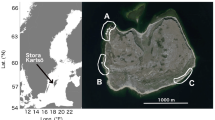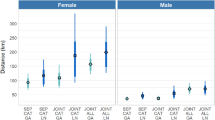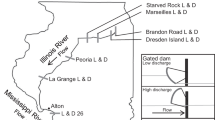Abstract
Mark-recapture estimators assume no loss of marks to provide unbiased estimates of population parameters. We describe a hidden Markov model (HMM) framework that integrates a mark loss model with a Cormack–Jolly–Seber model for survival estimation. Mark loss can be estimated with single-marked animals as long as a sub-sample of animals has a permanent mark. Double-marking provides an estimate of mark loss assuming independence but dependence can be modeled with a permanently marked sub-sample. We use a log-linear approach to include covariates for mark loss and dependence which is more flexible than existing published methods for integrated models. The HMM approach is demonstrated with a dataset of black bears (Ursus americanus) with two ear tags and a subset of which were permanently marked with tattoos. The data were analyzed with and without the tattoo. Dropping the tattoos resulted in estimates of survival that were reduced by 0.005–0.035 due to tag loss dependence that could not be modeled. We also analyzed the data with and without the tattoo using a single tag. By not using.
Supplementary materials accompanying this paper appear on-line.

Similar content being viewed by others
References
Arnason, A. N. and Mills, K. H. (1981), “Bias and loss of precision due to tag loss in Jolly-Seber estimates for mark-recapture experiments,” Canadian Journal of Fisheries and Aquatic Sciences, 38, 1077–1095.
Beverton, R. and Holt, S. (1957), On the Dynamics of Exploited Fish Populations, Fishery Investigations Series II Volume XIX, Ministry of Agriculture, Fisheries and Food.
Borchers, D. L. (1996), “Line transect estimation with uncertain detection on the trackline,” PhD thesis, University of Cape Town, South Afica.
Borchers, D. L., Laake, J. L., Southwell, C., and Paxton, C. G. M. (2006), “Accommodating unmodeled heterogeneity in double-observer distance sampling surveys,” Biometrics, 62, 372–378.
Bradshaw, C. J. A., Barker, R. J., and Davis, L. S. (2000), “Modeling tag loss in New Zealand fur seal pups,” Journal of Agricultural Biological and Environmental Statistics, 5, 475–485.
Braun-McNeill, J., SAsso, C. R., and Avens, L. (2007), “Estimates of realized survival for juvenile loggerhead sea turtles (Caretta caretta) in the United States,” Herpetological Conservation and Biology, 2, 100–105.
Cameron, M. F. and Siniff, D. B. (2004), “Age-specific survival, abundance, and immigration rates of a Weddell seal (Leptonychotes weddellii) population in McMurdo Sound, Antarctica,” 82, 601–615.
Carver, A., Burger, L., and Brennan, L. (1999), “Passive integrated transponders and patagial tag markers fror northern bobwhite chicks,” Journal of Wildlife Management, 63, 162–166.
Casale, P., Mazaris, A., Freggi, D., Basso, R., and Argano, R. (2007), “Survival probabilities of loggerhead sea turtles (Caretta caretta) estimated from capture-mark-recapture data in the Mediterranean Sea,” Scientia Marina, 71, 365–372.
Chilvers, B. L. and MacKenzie, D. (2010), “Age- and sex-specific survival estimates incorporating tag loss for New Zealand sea lions, Phocarctos hookeri,” Journal of Mammalogy, 91, 758–767.
Conn, P. B., Kendall, W. L., and Samuel, M. D. (2004), “A general model for the analysis of mark-resight, mark-recapture, and band-recovery data under tag loss,” Biometrics, 60, 900–909.
Cowen, L. and Schwarz, C. J. (2006), “The Jolly-Seber model with tag loss,” Biometrics, 62, 699–705.
Diefenbach, D. R. and Alt, G. L. (1998), “Modeling and evaluation of ear tag loss in black bears,” Journal of Wildlife Management, 62, 1292–1300.
Diefenbach, D. R., Laake, J. L., and Alt, G. L. (2004), “Spatio-temporal and demographic variation in the harvest of black bears: Implications for population estimation,” Journal of Wildlife Management, 68, 947–959.
Feldheim, K. A., Gruber, S. H., de Marignac, J. R. C., and Ashley, M. V. (2002), “Genetic tagging to determine passive integrated transponder tag loss in lemon sharks,” Journal of Fish Biology, 61, 1309–1313.
Fokidis, B., H, Robertson, C., and Risch, T. (2006), “Keeping tabs: Are redundant marking systems needed for rodents?” Wildlife Society Bulletin, 34, 764–771.
Forcada, J. and Robinson, S. L. (2006), “Population abundance, structure and turnover estimates for leopard seals during winter dispersal combining tagging and photo-identification data,” Polar Biology, 29, 1052–1062.
Fosgate, G., Adesiyun, A., and Hird, D. (2006), “Ear-tag retention and identification methods for extensively managed water buffalo (Bubalus bubalis) in Trinidad,” Preventive Veterinary Medicine, 73, 287–296.
Hastings, K. K., Small, R. J., and Pendleton, G. (2012), “Sex-and age-specific survival of harbor seals (Phoca vitulina) from Tugidak Island, Alaska,” Journal of Mammalogy, 93, 1368–1379.
Hernández-Camacho, C. J., Aurioles-Gamboa, D., Laake, J., and Gerber, L. R. (2008), “Survival rates of the California sea lion, Zalophus californianus, in Mexico,” Journal of Mammalogy, 89, 1059–1066.
Hyun, S.-Y., Reynolds, J. H., and Galbreath, P. F. (2012), “Accounting for tag loss and its uncertainty in a mark-recapture study with a mixture of single and double tags,” Transactions of the American Fisheries Society, 141, 11–25.
Juillet, C., Choquet, R., Gauthier, G., and Pradel, R. (2010), “A capture-recapture model with double-marking, live and dead encounters, and heterogeneity of reporting due to auxiliary mark loss,” Journal of Agricultural, Biological, and Environmental Statistics, 16, 88–104.
Knudsen, C. M., Johnston, M. V., Schroder, S. L., Bosch, W. J., Fast, D. E., and Strom, C. R. (2011), “Effects of Passive Integrated Transponder Tags on Smolt-to-Adult Recruit Survival, Growth, and Behavior of Hatchery Spring Chinook Salmon,” North American Journal of Fisheries, 29, 658–669.
Laake, J. (1999), “Distance sampling with independent observers: Reducing bias from heterogeneity by weakening the conditional independence assumption,” in Marine Mammal Survey and Assessment Methods, Rotterdam: A. A. Balkema, pp. 137–148.
——— (2013a), “Capture-recapture analysis with hidden Markov models,” AFSC Processed Rep. 2013-04, 35p. Alaska Fish. Sci. Cent., NOAA, Natl. Mar. Fish. Serv., Seattle, WA 98115.
——— (2013b), “RMark: An R interface for analysis of capture-recapture data with MARK,” AFSC Processed Rep. 2013-01, 25p. Alaska Fish. Sci. Cent., NOAA, Natl. Mar. Fish. Serv., Seattle, WA 98115.
Laake, J. and Borchers, D. (2004), “Methods for incomplete detection at distance zero,” in Advanced Distance Sampling, ed. S.T. Buckland, K.P. Burnham, J.L. Laake, D.L. Borchers, L. Thomas, and D. R. Anderson, chap. 6, Oxford: Oxford University Press, pp. 108–189.
Laake, J. L., Johnson, D. S., and Conn, P. B. (2013), “marked: An R package for maximum-likelihood and MCMC analysis of capture-recapture data,” Methods in Ecology and Evolution, 4, 885–890.
Mackey, B. L., Durban, J. W., Middlemas, S. J., and Thompson, P. M. (2008), “A Bayesian estimate of harbour seal survival using sparse photo-identification data,” Journal of Zoology, 274, 18–27.
McMahon, C. R., Burton, H. R., Van Den Hoff, J., Woods, R., and Bradshaw, C. J. A. (2006), “Assessing hot-iron and cryo-branding for permanently marking southern elephant seals,” Journal of Wildlife Management, 70, 1484–1489.
McMahon, C. R. and White, G. C. (2009), “Tag loss probabilities are not independent: Assessing and quantifying the assumption of independent tag transition probabilities from direct observation,” Journal of Experimental Marine Biology and Ecology, 372, 36–42.
Melin, S. R., Laake, J. L., DeLong, R. L., and Siniff, D. B. (2012), Age-specific recruitment and natality of California sea lions at San Miguel Island, California,” Marine Mammal Science, 28, 751–776.
Merrick, R. L., Loughlin, T. R., and Calkins, D. (1996), “Hot branding: A technique for long-term marking of pinnipeds,” U.S. Department of Commerce, NOAA Technical Memorandum NMFS-AFSC-68.
Oosthuizen, W., Nico de Bruyn, P. J., Bester, M. N., and Girondot, M. (2010), “Cohort and tag-site-specific tag-loss rates in mark-recapture studies : A southern elephant seal cautionary case,” Marine Mammal Science, 26, 350–369.
Pistorius, P. A., Bester, M. N., Kirkman, S. P., and Boveng, P. L. (2000), “Evaluation of age- and sex-dependent rates of tag loss in southern elephant seals,” Journal of Wildlife Management, 64, 373–380.
R Core Development Team (2012), R: A Language and Environment for Statistical Computing, R Foundation for Statistical Computing, Vienna, Austria, URL http://www.R-project.org/. URL http://www.r-project.org/.
Rivalan, P., Godfrey, M. H., Prevot-Julliard, A. C., and Girondot, M. (2005), “Maximum likelihood estimates of tag loss in leatherback sea turtles,” Journal of Wildlife Management, 69, 540–548.
Rotella, J. J. and Hines, J. E. (2005), “Effects of tag loss on direct estimates of population growth rate,” Ecology, 86, 821–827.
Seber, G. (1982), The Estimation of Animal Abundance and Related Parameters, 2nd Edition, Edward Arnold: London.
Siniff, D. B. and Ralls, K. (1991), “Reproduction, survival and tag loss in California sea otters,” Marine Mammal Science, 7, 211–229.
Smout, S., King, R., and Pomeroy, P. (2011a), “Estimating demographic parameters for capture-recapture data in the presence of multiple mark types,” Environmental and Ecological Statistics, 18, 331–347.
——— (2011b), “Integrating heterogeneity of detection and mark loss to estimate survival and transience in UK grey seal colonies,” Journal of Applied Ecology, 48, 364–372.
Stevick, P. T., Palsboll, P. J., Smith, T. D., Bravington, M. V., and Hammond, P. S. (2001), “Errors in identification using natural markings: rates, sources, and effects on capture-recapture estimates of abundance,” Canadian Journal of Fisheries and Aquatic Sciences, 58, 1861–1870.
Tavecchia, G., Adrover, J., Navarro, A. M., and Pradel, R. (2012), “Modelling mortality causes in longitudinal data in the presence of tag loss: application to raptor poisoning and electrocution,” Journal of Applied Ecology, 49, 297–305.
White, G. C. and Burnham, K. P. (1999), “Program MARK: survival estimation from populations of marked animals,” Bird Study, 46, 120–139.
Acknowledgments
We thank Mevin Hooten and Jefferson Hinke for their review of a previous draft. We also thank Mark Lindberg and Richard Barker for their suggestions. Any use of trade, firm, or product names is for descriptive purposes only and does not imply endorsement by the U.S. Government. The findings and conclusions in the paper are those of the authors and do not necessarily represent the views of the National Marine Fisheries Service, NOAA.
Author information
Authors and Affiliations
Corresponding author
Electronic supplementary material
Below is the link to the electronic supplementary material.
Appendix
Appendix
The probability structure for mark loss is equivalent to capture-recapture (mark-recapture) for two occasions with a closed population, which has been used with two observers to measure detection probability in visual surveys. When detection probability is measured solely with the mark-recapture data, it is necessary to assume independence between the detections by the two observers because those missed by both observers (\(n_{00})\) are obviously not included in the sample (Borchers 1996). Recently, the independence assumption was weakened (Laake 1999; Laake and Borchers 2004; Borchers et al. 2006) in the combined mark-recapture and distance sampling by including a dependence measure \(\delta (x)\) which was estimated as the discrepancy between the detection probability at distance \(x\) measured by the mark-recapture (double observer) data (based on independence) and the distance sampling data. If \(\delta (x)\) = 1 then independence at all distances is achieved. Because detection probability at \(x\) = 0 cannot be measured from the distance sampling data, the independence assumption for the mark-recapture data was required for \(x\) = 0 (\(\delta \)(0) = 1) but not for the other distances.
The dependence structure we have defined for mark loss can be expressed in terms of the \(\delta \) dependence of Borchers et al. (2006). Under the independence model, the probability that an animal would retain at least one mark is:
Likewise for the dependence model:
The dependence measure of Borchers et al. (2006) is a ratio that measures the distortion between the joint probabilities from the independence model (\(\beta _{3}=0\)) and the dependence model (\(\beta _{3}\ne 0\)) which can be expressed as:
The same relationship can be obtained using conditional and marginal probabilities. Defining \(\tau _{i}^{(s_{3-i})}\) to be the conditional probability that the \(i\)th mark is lost given the other mark status is \(s_{3-i}\):
If \(q_{i}^{(s_{3-i})}=1-\tau _{i}^{(s_{3-i})}\)and \(q_{i}=1-\tau _{i}\) is the marginal mark retention rate, then \(\delta =q_{i}^{(1)}/q_{i}=\frac{K}{K^{*}}\). Likewise the same ratio for any of the joint probabilities based on independence and dependence other than for the (0,0) event which is not used in the independence model. The dependence measure can also be expressed in terms of covariance (Borchers 1996):
In general there will likely be positive dependence in mark loss which means \(\beta _{3}> 0\) and \(\delta > 1\) but negative dependence \((\beta _{3} < 0)\) is possible with a lower bound of \(\delta > 1-\tau _{00}^{*}\).
The joint probabilities can be rewritten in terms of \(\delta \) as: \(\tau _{11}=\delta q_{1}q_{2}, \, \tau _{10}=q_{1}(1-\delta q_{2})\) and \(\tau _{01}=q_{2}\left( 1-\delta q_{1}\right) \) or as \(\tau _{11}=q_{1}^{(1)}q_{2}^{(1)}/\delta ,\, \tau _{10}=q_{1}^{(1)}\tau _{2}^{(1)}/\delta \) and \(\tau _{01}=q_{2}^{(1)}\tau _{1}^{(1)}/\delta \). The latter form makes it obvious that once you exclude \(n_{00}\) and condition on the observed data, the \(\delta \) will cancel from the rescaled joint probabilities which will only be functions of the \(q_{i}^{1}\). This is also obvious by noting that the joint probabilities for the observed set of data (\(n_{11}n_{10}n_{01})\) would only be functions of \(\beta _{i}\) after conditioning on the exclusion of \(n_{00}\). The same result was shown by Borchers et al. (2006) for mark-recapture distance sampling but in that case \(\delta \) could be estimated from the observed distances.
Rights and permissions
About this article
Cite this article
Laake, J.L., Johnson, D.S., Diefenbach, D.R. et al. Hidden Markov Model for Dependent Mark Loss and Survival Estimation. JABES 19, 522–538 (2014). https://doi.org/10.1007/s13253-014-0190-1
Received:
Accepted:
Published:
Issue Date:
DOI: https://doi.org/10.1007/s13253-014-0190-1




